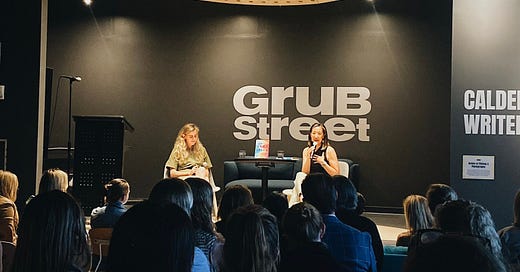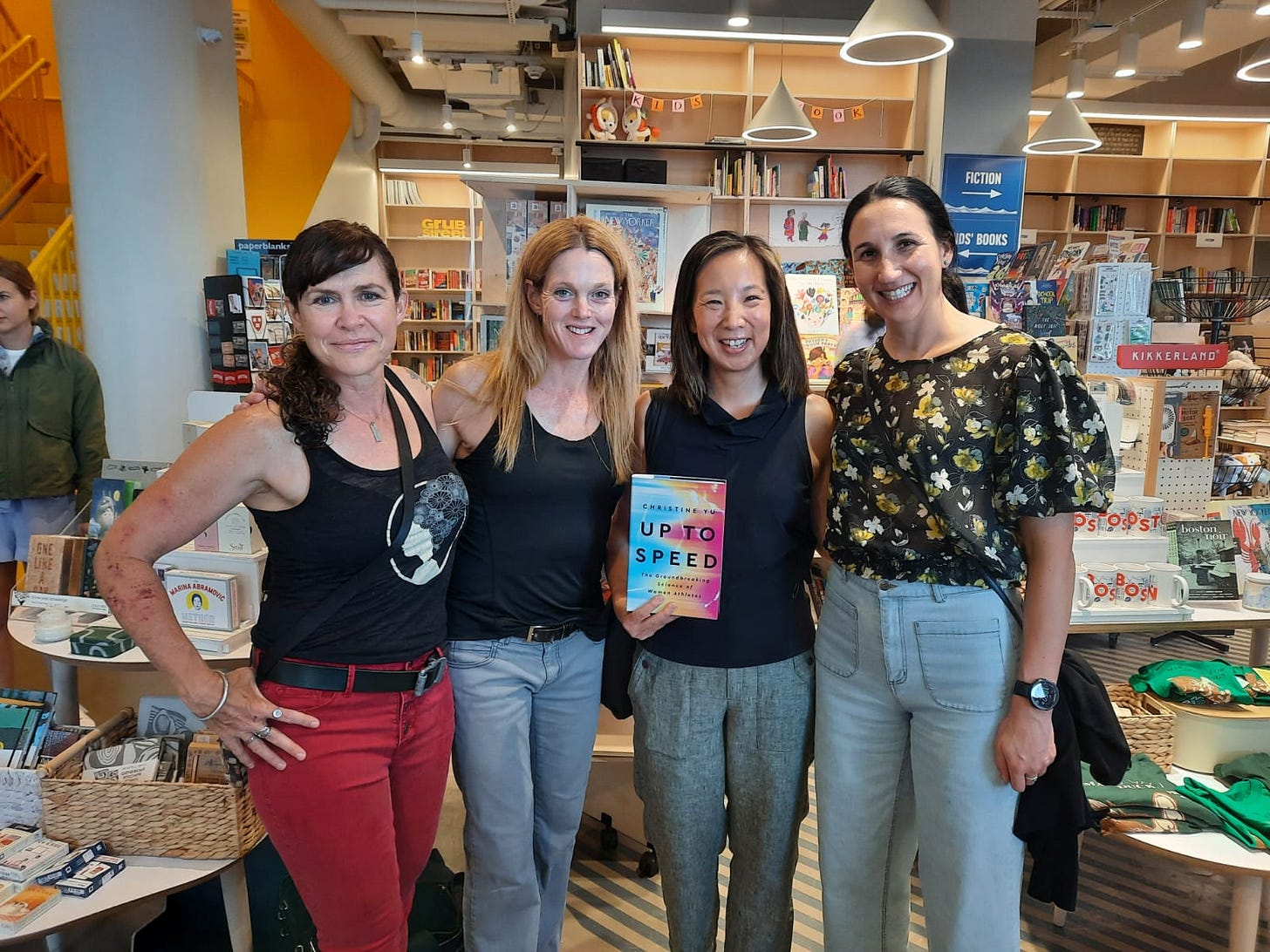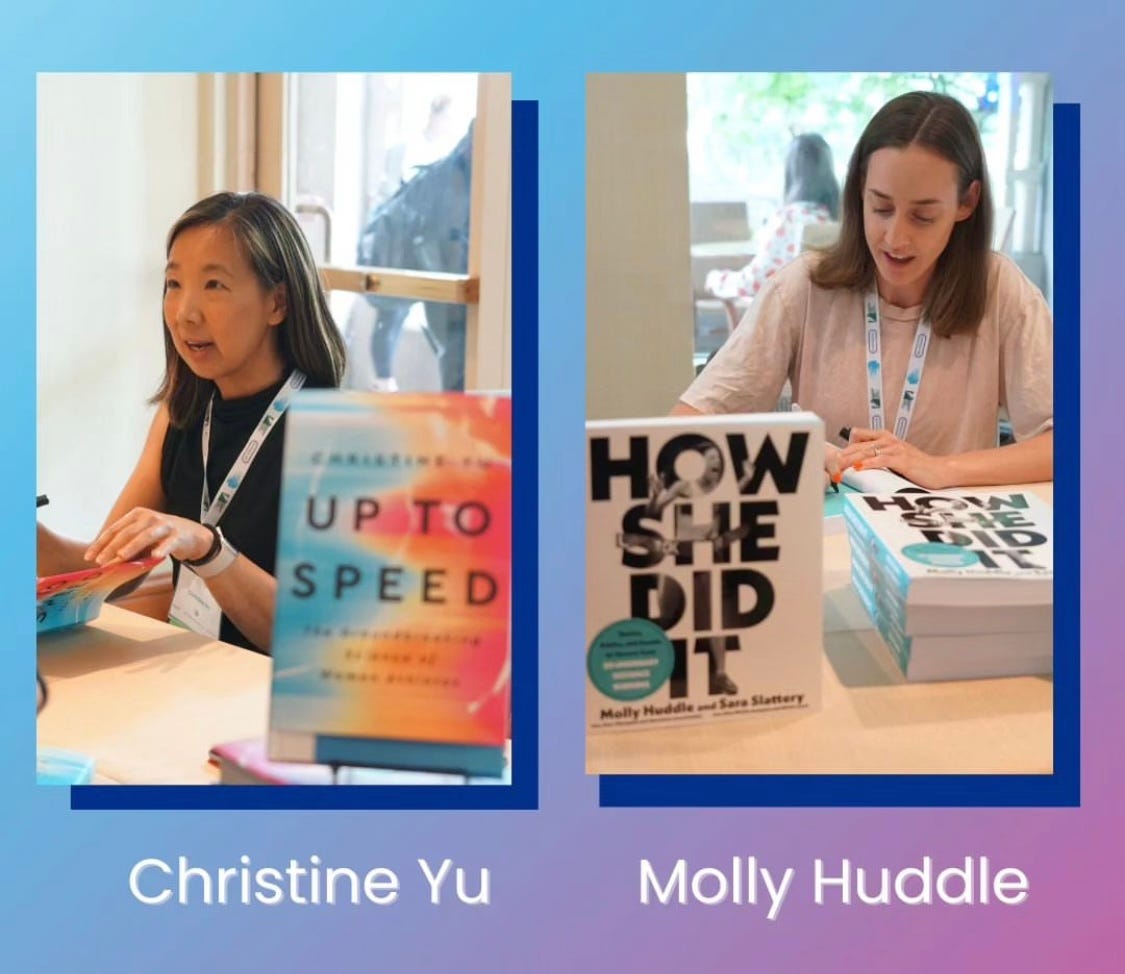Highlights from the Female Athlete Conference
aka a gathering of the who's who in female athlete research
Book tour is coming to an end and I’d love to see you! I have three remaining events:
July 9, 7pm ET: Virtual Book club with the Women’s Running Coaches Collective open to members and non-members. Register here.
July 11: Santa Monica! Details coming!
July 13, 7pm PT: Pasadena! Book talk with Run With Us Pasadena
Two weeks ago, I headed up to Boston to attend the Female Athlete Conference. The conference in the brainchild of Dr. Kate Ackerman, the director of the Female Athlete Program at Boston Children’s Hospital, and is dedicated to closing the gender research gap in sports science and improvement treatment and development of female athletes. The conference is essentially a gathering of the who’s who in the field of female athlete research.
Sessions covered a wide range of topics: menstrual health and performance, hormonal contraceptive use, relative energy deficiency-in sport (RED-S), mental health, injuries (knee, hip, bone stress), postpartum return to running, concussion, menopause, and eating disorders. There were fantastic keynote speakers and panels.
It was three very full days. So much information.
Since it would be impossible to recap the whole thing, I wanted to share a couple of highlights.
Mary Cain’s keynote speech
Mary is a former professional runner—the 2014 World Junior Champion in the 3000m—founder of Atalanta NYC, and champion for athlete well-being and gender equity.
I think everyone in the audience expected Mary to talk about her experience with the Nike Oregon Project, which she shared in a 2019 New York Times Op-Ed. Instead, she talked (publicly for the first time) about why she hasn’t run professionally, or really run for that matter, in several years.
When she ran, she would lose sensation in her leg. Eventually, it would go numb when she walked. She saw countless doctors and specialists, anyone who she thought could help, but no one could figure out what was wrong. It took seven years for her to get a diagnosis: popliteal artery entrapment syndrome (PAES).
Mary made an interesting point about pain. While it might not seem like a big deal, pain—or the lack of pain—can be a barrier that keeps athletes from getting the care they need. Doctors evaluate symptoms based on a pain scale and if you’re in pain, they seem to take your complaints more seriously, as a sign that it’s greatly affecting your life.
Mary didn’t have pain, even though it’s considered one of the main symptoms of PAES. Not only that, athletes, especially those performing at high levels of sport, are conditioned to push past pain. Their evaluation of pain likely will be quite different from my evaluation of pain or your evaluation of pain.
Instead asking how much pain are you experiencing, she said, what if they asked—how much is this affecting your life? If that was the question, she would have answered a 9 or 10.
Her experience highlights how hard it is for women, especially women athletes, to get appropriate care. It echoes stories I’ve heard from other athletes and that sense of medical gaslighting is heightened when we don’t have adequate research on certain populations (cough cough women).
Don’t get me wrong. Obviously it’s important to pay attention to pain and other physical symptoms but oftentimes conditions/health concerns don’t always line up with physical manifestations of symptoms. By asking a broader question like “how is this affecting your life,” we’re able to capture the bigger picture and provide a better context within which to evaluate what might really be going on.
The Translation Gap
One of the things that I love about the Female Athlete Conference is that it’s a chance to nerd out on the latest scientific findings—during the conference sessions itself and the poster session. But this year, there was a greater attention on bigger picture issues related to women in sports—mental health, intersectionality, postpartum return to sport, safeguarding athletes in sport, and challenges facing professional athletes in the NWSL.
These are big, important issues that we need to discuss and address if we want to continue to advance women’s sports and support women athletes. But we also need to do something about it. How do we actually start to facilitate change?
One of the biggest barriers is the translation gap, the gap between what happens in the lab and what the general public knows and understands. But it’s also the gap between the latest science and what doctors, coaches, and athletic training staff know and how they advise athletes.
For example, if we’ve know about the dangers of irregular or absent menstrual cycles since the late 1980s and early 1990s, why do so many girls, women, and coaches (and some doctors) think that losing your menstrual cycle is normal for someone who plays sports? Why does it constantly feel like we have the memory of goldfish and we have to raise the alarm again and again and again?
Rich Burden from the UK Sport Institute (formerly the English Institute of Sport) had an interesting point. He works with Olympic and Paralympic athletes and said that sports organizations are risk-adverse. There’s the “inertia of success” that makes it hard to push for innovation and change because there’s a bias to stick to what has worked in the past.
Plus, Olympic and Paralympic athletes are on a four-year cycle, leaving sports scientists with a small window of time to show results. If they can’t show results, the athletes and sports organizations aren’t going to be interested. However, science is slow and research experiments don’t always line up with those timelines.
How do we disseminate the information better? How do we create a pipeline to funnel this information to coaches and others working with athletes and active people? How do we create change? How do we counter the noise that’s on social media too?
I’m curious to hear your thoughts on this topic.
Mental Health
Conversations about mental health threaded through many sessions (even ones that weren’t explicitly about mental health) and conversations in the hallways. There were discussions about how mental health is intertwined with athlete health but also discussions about abuse and what we can do to better protect athletes in sport, how we can help athletes with the transition out of sport, and the effects of social media.
In particular, I really appreciated the discussion between Mary Cain, Victoria Heiligenthal and Madison Mooney (who both ran at the University of Wisconsin-Madison and were teammates of Sarah Shulze who died by suicide last year), and Ivy Watts (a former all-American student athlete who has also struggled with mental health issues) and hearing their perspective about the challenges student-athletes and young athletes face. It’s a sticky situation when adults are in the position to benefit from the performance of youth athletes. When you think of it in that context, it’s no surprise that abuse is rampant in sport as are problematic cultures.
Right now, it feels like we get statements from universities that they investigated allegations but it’s unclear what that really means or if any changes have been or will be made. Or universities make a big show of saying that mental health resources are available to students which, while great, still puts the onus on the student to seek out those services. Plus, students need to be in a situation where they feel comfortable seeking out those services in the first place. That means that coaches and athletic staff also need to buy into creating a culture where discussion about mental health is normalized. You should be able to seek mental health like you’d see a trainer to check the pain in your knee.
Case in point: Last week, the University of Colorado released the findings from their internal investigation into the school’s cross country and track and field programs after former student athletes alleged they were negatively impacted by coaching practices (such as the use of body composition analysis) and the overall culture of the team. Cindy Kuzma did a great job following and reporting this story for months for Runner’s World and Alison Wade at
provided great commentary on the situation and summarized some of the more troubling findings in the report. It’s definitely worth reading if you haven’t read it yet.Three things struck me:
No one lost their job even though the investigation found that the practices caused significant harm to some student athletes and other athletic department staff were concerned;
How much weight (no pun intended) the coaching staff and director of performance nutrition placed on body composition as the key to success; and
The difference in team culture between the men’s and women’s teams where the women’s team was found to be more cutthroat and cliquish.
Relative Energy Deficiency in Sport (RED-S)
RED-S was everywhere!
There was one interesting study that looked at low energy availability (LEA) at the 2022 Boston Marathon among non-elite runners, men and women. The researchers found that among both men and women, athletes who had indications of LEA finished lower in their category compared to those without any indication of LEA. They were also at greater risk of requiring medical support or having a significant medical event.
The exciting piece of news is that a new International Olympic Committee (IOC) Consensus Statement on RED-S will be released later this year.
Other Boston Highlights
Book event at Porter Square Books with Mary Cain: I realize that Mary’s name has come up a lot in this newsletter but this one is special to me personally. On a whim, I asked her if she would be my conversation partner at an event the night before the conference started. Mind you, it was also the night before her keynote. She graciously agreed and was an incredible conversation partner. I will admit, I was nervous before this event because I didn’t have a huge built in audience in Boston but people showed up! Including my friend Sarah, who made the drive down from New Hampshire, and my friend Lisa, who I went to grad school with and haven’t seen in 20 years!
Book signing at the conference with Molly Huddle: Molly and I got to sell and sign books on the last day of the conference. It was great to finally meet Molly in person and really reaffirming to see so much interest in our books.
Networking: I hate networking but at the conference I got to meet so many of the people I interviewed for the book. Since I did most of my reporting during COVID, I didn’t get a chance to meet them in person. I appreciated the opportunity to chat and thank them in person. Plus, since I’m a sentimental dork, I asked them (as many of them as I could find) to sign my copy of the book—like a yearbook! You can see if in the last slide here.
What I’m Reading
Allyson Felix’s op-ed about the death of her teammate Tori Bowie and the Black maternal health crisis
Next year, DC will implement new standards for menstrual health education. We need more efforts like this to normalize education about menstrual health.
Really interesting article on exercise and the line between good-for-you and excessive.
Thank you for being here. More soon.
Christine








